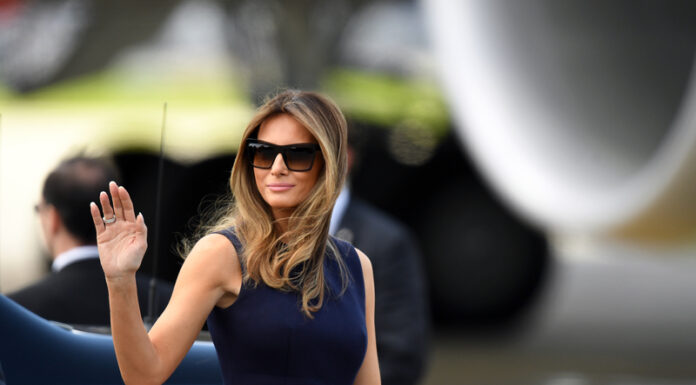Fashion magazine Vogue has ignited a fierce media debate with its critical review of First Lady Melania Trump’s official White House portrait, published in a fashion op-ed on January 29, 2025.
The portrait release is historically significant, marking President Trump’s return to the White House after winning a second non-consecutive term as First Lady. The critique by Vogue has highlighted evolving tensions between the fashion industry’s elite and political figures, particularly given the magazine’s past coverage patterns of First Ladies.
The magazine’s fashion writer Hannah Jackson delivered a pointed critique of Trump’s portrait, focusing on her choice of attire – a black Dolce & Gabbana tuxedo jacket, white button-up shirt, and Ralph Lauren cummerbund. Jackson wrote that the ensemble made Trump look “more like a freelance magician than a public servant” and characterized the portrait as a “boardroom pastiche” that better suited her husband’s former reality show “The Apprentice” than an official White House photograph.
The article referenced Trump’s previous fashion choices, including the controversial “I Really Don’t Care, Do U?” jacket she wore during a visit to a migrant detention center during her first term as First Lady. Jackson suggested that Trump’s fashion selections often carry specific messages, arguing that her refusal to “abandon theatrics” stems from her connection to “a reality-television empire” and her residence in a “gold-encrusted penthouse.”
Jackson acknowledged that the new portrait shows improvement from Trump’s 2017 version, which the writer described as “airbrushed into oblivion.” Still, the critique expanded beyond personal styling to include broader commentary on the family’s presentation of wealth and power. Vogue noted the shift from Trump’s previous portrait, which featured a prominent diamond ring, to the current image’s emphasis on connections to tech CEOs present at the 2025 inauguration.
The review drew parallels to other Trump family fashion choices, explicitly criticizing Ivanka Trump’s inaugural ball gown, which was inspired by Audrey Hepburn’s dress in “Sabrina.” The magazine characterized this choice as “misguided” within the “political realm,” suggesting a pattern of prioritizing glamour over traditional political imagery.
The critique has reignited a long-standing rift between Vogue and the First Lady. During her previous White House tenure, Trump was notably excluded from the magazine’s covers, breaking Vogue’s tradition of featuring First Ladies. The magazine’s editor-in-chief, Anna Wintour, had previously praised former First Lady Michelle Obama while avoiding acknowledging Trump. When asked about her absence from the magazine’s cover, Trump stated she “had much more important things to do than be on the cover.”
Conservative commentators have responded forcefully, describing Trump as a “portrait of beauty, style, elegance and power” and accusing Vogue of displaying “poisonous venom” and “mean girl” behavior. Critics have highlighted the magazine’s contrasting treatment of Democratic figures, noting its multiple cover features of former First Lady Jill Biden and Vice President Kamala Harris. The dispute has evolved beyond fashion critique into a broader debate about political representation in mainstream media.
Social media response to the portrait has been divided, with Trump’s supporters praising the image’s intensity and aesthetic quality. Some observers have questioned whether the picture has undergone digital enhancement, while others have drawn comparisons to professional magazine covers.
Vogue has maintained its editorial stance, with the article remaining published despite significant backlash. The White House has not officially responded to the magazine’s critique.







